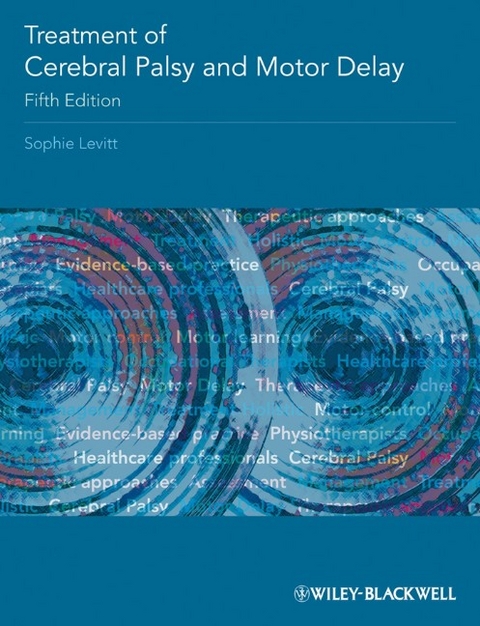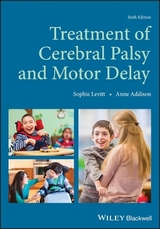
Treatment of Cerebral Palsy and Motor Delay
Wiley-Blackwell (an imprint of John Wiley & Sons Ltd) (Verlag)
978-1-4051-7616-3 (ISBN)
- Titel ist leider vergriffen;
keine Neuauflage - Artikel merken
Parents, families and also teachers of people with cerebral palsy can learn more about therapy by consulting the book together with their therapist. Written by an international authority in the field Extensively revised, updated and well referenced Emphasises an eclectic, functional and holistic approach Highly illustrated Promotes positive relationships between therapists, people with cerebral palsy and their families From the Foreword: "I greatly welcome the fifth edition of this book which brings together the management of cerebral palsies into a comprehensive but readable form...This book is in my view an essential part of both a therapist's and doctor's basic understanding of the subject...This book remains essential for those managing children with disability." --Brian Neville, Professor of Childhood Epilepsy, Professor of Paediatric Neurology, University College London, Institute of Child Health/Great Ormond Street Hospital for Children NHS Trust.
Sophie Levitt is a specialist physiotherapist and tutor in developmental paediatrics and neurology. Her career has encompassed high profile therapy posts in London. She currently lectures and consults to a variety of professionals involved in the field of cerebral palsy, both in the UK and overseas.
Foreword Preface Acknowledgements 1 The clinical picture for therapy and management The motor dysfunction Associated impairments and disabilities Aetiology Clinical picture and development Classification Spastic cerebral palsy Athetoid (dyskinetic, dystonic) cerebral palsy Ataxic cerebral palsy Common features in all types of cerebral palsies Motor delay Principles of learning and therapy Summary 2 A collaborative learning approach Working with parents Collaboration with other adults The collaborative learning approach Opportunities to discover what parents and child want to achieve Opportunities to clarify what is needed for these achievements, to recognise what they already know and can do and to find out what they still need to learn and do Participation in the selection and use of methods Participation in the evaluation of progress Parent-child interaction Helping a child to learn motor control Observation of parent and child interaction Emotional support Parents' health Teamwork with parents Siblings Records Alternative and complementary treatments Contraindications Summary 3 Outline of treatment approaches Muscle education and braces Progressive pattern movements Proprioceptive neuromuscular facilitations (PNF) Neuromotor development Neurodevelopmental treatment (Bobath approach) Sensory stimulation for activation and inhibition Reflex creeping and other reflex reactions Conductive education Sensory integration Adjuncts to therapy Systems-based task-oriented approach Mobility opportunities via education (MOVE) Contemporary theories 4 Evidence-based practice Research and clinical studies Research on treatment approaches Theoretical grounds Research studies Reviews of research studies Studies of specific treatment systems Research on specific procedures Other research Clinical experience with evidence-based practice The appraisal of research studies for therapy 5 Synthesis of treatment systems The eclectic viewpoint in therapy Synthesis of treatment systems The postural mechanisms Voluntary motion Perceptual-motor function principles for a synthesis of therapy systems Developmental training Treatment of abnormal tone Training of movement patterns Use of afferent stimuli Management of deformity 6 Learning motor function Learning methods The development of a child's attention and learning Practical ideas to promote attention and learning Learning a motor function A child's own goals and strategies Task analysis Cues for learning Verbal guidance Rewards Practice and experience Summary 7 The older person with cerebral palsy Role of the physiotherapist and occupational therapist Studies of function Issues of concern in the older person Motor abilities and self-care activities Deformities Healthy lifestyle Develop appropriate community mobility Training of self-care and cosmetic appearance Knowledge about the condition Therapeutic motor activities Measures 8 Assessment for therapy and daily function Approach to assessment Assessment and measurements Specific functional items Measures of upper extremity and hand function Methods of observation of gait Grading in assessments Additional assessment required Records Summary 9 Treatment procedures and management Motor training Motor development and the child with severe visual impairment Prone development Supine development Development of sitting Development of standing and walking Abnormal postures in standing (see Figs 9.166-9.169) Lower limb orthoses for standing and walking Development of hand function 10 Motor function and the child's daily life Motor function in feeding, dressing, toileting, washing, bathing, play and communication Motor function and perception Motor function and communication, speech and language Development of communication - brief summary Development of feeding - brief summary Development of dressing - brief summary Development of play - brief outline Techniques for carrying the child correctly (Figs 10.6-10.11) 11 Management of deformity Causes of deformities and aims of therapy and management Deformities and gait Therapy and daily care Review of deformities Arm deformity Deformities of trunk and neck General considerations related to surgery Pre-operative physiotherapy Post-operative physiotherapy and care 12 Therapeutic group work General management of groups Selection of children The programme Summary Appendix 1: Developmental levels Physical ability assessment guide Prone Supine Sitting Standing and walking Wheelchair use Appendix 2: Equipment Basic equipment Aids to activities of daily living General References Index
| Erscheint lt. Verlag | 12.2.2010 |
|---|---|
| Verlagsort | Chichester |
| Sprache | englisch |
| Maße | 189 x 245 mm |
| Gewicht | 738 g |
| Themenwelt | Medizin / Pharmazie ► Medizinische Fachgebiete ► Neurologie |
| Medizin / Pharmazie ► Medizinische Fachgebiete ► Pädiatrie | |
| Medizin / Pharmazie ► Physiotherapie / Ergotherapie ► Ergotherapie | |
| ISBN-10 | 1-4051-7616-4 / 1405176164 |
| ISBN-13 | 978-1-4051-7616-3 / 9781405176163 |
| Zustand | Neuware |
| Informationen gemäß Produktsicherheitsverordnung (GPSR) | |
| Haben Sie eine Frage zum Produkt? |
aus dem Bereich



